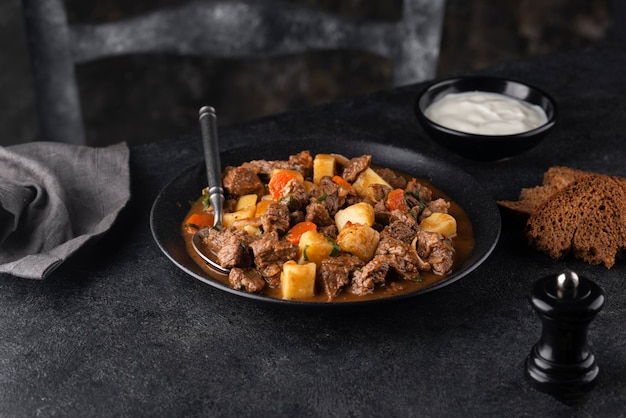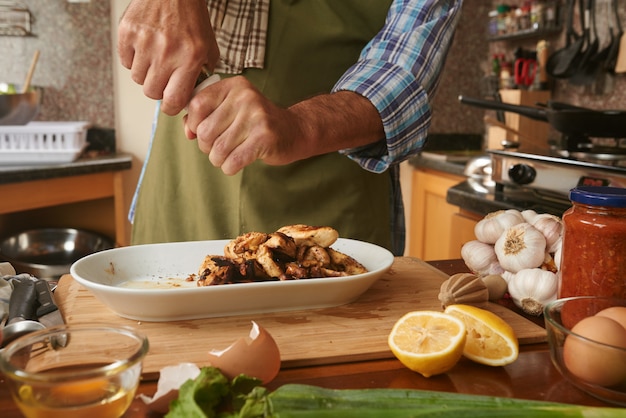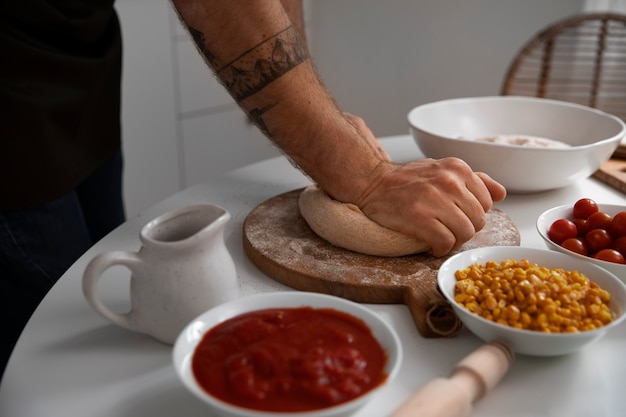Oh, corned beef. Just the name evokes images of hearty meals, smoky aromas, and a taste that transports you straight to a cozy Irish pub. But honestly, the thought of cooking corned beef can be intimidating. "Is it complicated?" you might ask. "Will it turn out tough?" Fear not, my friend! With this guide, you'll be whipping up the most tender, flavorful slow-cooked corned beef you've ever tasted – guaranteed.
I've been perfecting my corned beef recipe for years, experimenting with different techniques and ingredients to achieve that perfect melt-in-your-mouth texture and a depth of flavor that’s simply irresistible. It's a journey of culinary discovery that I'm delighted to share with you.
So grab your favorite mug, brew a pot of tea, and let's dive in! Together, we'll explore everything from choosing the right cut of beef to crafting the most delicious slow-cooked masterpiece.
(Part 1) Corned Beef: A culinary journey

Before we get our hands dirty, let's take a quick trip down memory lane. Corned beef, a staple in many cultures, has a fascinating history. It's deeply rooted in Irish and Jewish cuisine, where it's been enjoyed for generations. But what exactly is corned beef?
Imagine a cut of beef, typically brisket or round, that's been transformed through a magical process called curing. This involves soaking the beef in a brine, a magical mixture of salt, sugar, and spices. The brine doesn't just preserve the meat, it infuses it with an incredible flavor profile. It's a true testament to the power of time and tradition.
Now, you might be thinking, "Brined meat? Sounds a little odd, doesn't it?" But trust me, it's anything but. This process does something truly remarkable – it tenderizes the meat and gives it a distinctive, savory taste that's unlike any other.
The Magic of slow cooking
Now, you might be wondering why we're focusing on slow-cooked corned beef. The answer is simple: it's a game-changer! The slow, gentle cooking process is the key to unlocking the meat's full potential.
Why is slow cooking so special? It's all about transformation. The slow, steady heat breaks down tough connective tissues, turning the meat into a symphony of tenderness. The flavor of the spices and brine has ample time to penetrate every nook and cranny, creating a symphony of taste.
And let's not forget the convenience. Slow cooking is the ultimate hands-off method. You simply throw the ingredients into your slow cooker, set it, and forget it. Perfect for busy weeknights or lazy weekends when you want to relax and let your kitchen work its magic.
(Part 2) The Beef: Choosing the Perfect Cut

Alright, let's get down to business! Choosing the right cut of beef is the foundation of a delicious slow-cooked corned beef. Two contenders typically rise to the top: brisket and round.
Brisket: A Classic Choice
Brisket, my personal favorite, is a cut with a rich history. It's a fatty cut, packed with flavor, but it can be a bit tough if not cooked correctly. This is where slow cooking shines! The long, slow cooking process transforms the tough connective tissues into a symphony of tenderness.
Brisket comes in two parts: the flat and the point. The flat is leaner and has a more even texture. The point, on the other hand, is fattier and has a more intense flavor. For the best results, I recommend using a whole brisket that includes both the flat and the point. This combination offers a perfect balance of flavor and texture. It's like a culinary dance between lean and flavorful, a true masterpiece!
Round: A Lean and Savory Option
Round, a leaner cut than brisket, is another popular choice for corned beef. It's often more affordable, but it can be a little tougher. If you're using round, I suggest using a lower setting on your slow cooker for a longer time to ensure it becomes beautifully tender.
When choosing round, look for a cut that's evenly marbled with fat. This will help to keep the meat moist and flavorful during cooking.
(Part 3) Prepping the Corned Beef: Setting the Stage

Right, you've got your perfect cut of beef – the star of our culinary show! Now, it's time to prepare the stage for a successful slow cook.
Rinse, Rinse, Rinse!
First, give your corned beef a thorough rinse under cold water. This removes any excess salt from the brine. Imagine washing away any lingering memories of the curing process, making way for a fresh, clean start. After rinsing, pat the beef dry with paper towels.
Trim the Fat, but Not Too Much
Next, we trim the fat. Don't go overboard! A little fat is essential for flavor and tenderness. Just trim off any large chunks of fat that could make the corned beef greasy.
Scoring the Meat: A Touch of Finesse
Here's where you can add a touch of finesse. Scoring the corned beef is optional, but it's a technique I love to use. Scoring involves making shallow cuts across the surface of the meat. This helps the flavors of the spices to penetrate deeper, ensuring every bit of the beef is infused with deliciousness. It also helps the corned beef cook more evenly.
Imagine those shallow cuts as tiny doorways, allowing the flavors to waltz right in and dance throughout the meat.
(Part 4) The Slow Cooker Symphony: A Recipe for Success
Alright, you're ready to start cooking! It's time to assemble the ingredients and create a symphony of flavor.
Ingredients:
- 3-4 pounds corned beef brisket or round
- 1 cup water
- 1 large onion, quartered
- 2-3 carrots, roughly chopped
- 2-3 celery stalks, roughly chopped
- 1 teaspoon black peppercorns
- 1 bay leaf
- 1/2 teaspoon dried thyme
- 1/4 cup brown sugar
Instructions:
- Place the corned beef in the slow cooker.
- Add the water, onion, carrots, celery, peppercorns, bay leaf, thyme, and brown sugar to the slow cooker.
- Cover and cook on low for 8-10 hours, or on high for 4-6 hours.
- When the meat is fork-tender, remove it from the slow cooker and set aside.
- Remove the vegetables from the slow cooker and set aside.
- Using a slotted spoon, skim off any excess fat from the cooking liquid.
- Strain the cooking liquid through a fine-mesh sieve into a saucepan.
- Return the strained cooking liquid to the saucepan and simmer over medium heat until reduced by about half, about 15-20 minutes.
- Slice the corned beef thinly against the grain.
- Serve the corned beef with the reduced cooking liquid (now a delicious gravy) and the cooked vegetables.
Pro Tips:
- For extra flavor, try adding a few cloves of garlic or a sprig of fresh parsley to the slow cooker.
- You can also add a few tablespoons of vinegar to the cooking liquid to help break down the meat and enhance the flavor.
- If you're feeling adventurous, you can even add a splash of beer or stout to the cooking liquid for a more complex flavor profile.
(Part 5) Serving Time: A Culinary Celebration
The moment of truth! Your corned beef is cooked and ready to be enjoyed. The possibilities for serving are endless, but here are a few of my favorite ways to celebrate the magic of slow-cooked corned beef.
Classic Corned Beef and Cabbage: A Timeless Delight
This is a classic combination for a reason. The tender corned beef pairs perfectly with the sweet and slightly bitter flavor of cabbage. You can simply steam the cabbage or braise it in the slow cooker with the corned beef.
corned beef sandwiches: A Culinary Comfort
Who doesn't love a good corned beef sandwich? Pile some thinly sliced corned beef onto a toasted rye bread, slather it with mustard, and you're good to go! You can add other toppings like sauerkraut, pickles, or even a dollop of Russian dressing.
Corned Beef Hash: A Hearty and Satisfying Feast
For a hearty and satisfying meal, try making corned beef hash. Simply combine the cooked corned beef with some diced potatoes, onions, and peppers, then sauté until golden brown. Serve it with a fried egg on top for extra indulgence.
corned beef soup: A Comforting and Flavorful Bowl
If you're looking for a comforting and flavorful soup, try making corned beef soup. Simply add the cooked corned beef, some of the cooking liquid, and some chopped vegetables to a pot, then simmer until the vegetables are tender.
(Part 6) Storing and Reheating: Preserving the Flavor
Leftovers? Don't worry, they'll be even better the next day! Here's how to store and reheat your slow-cooked corned beef, keeping those delicious flavors intact.
Storing the Goodness:
Once the corned beef has cooled down, transfer it to an airtight container and store it in the refrigerator for up to 4 days. You can also freeze the corned beef for up to 3 months. Just make sure to wrap it well in plastic wrap and then in foil.
Reheating with Care:
You can reheat the corned beef in the oven, microwave, or on the stovetop. I usually prefer to reheat it in the oven at 350 degrees fahrenheit (175 degrees Celsius) until it's heated through. This helps keep the meat moist and flavorful.
(Part 7) Beyond the Basics: Experimenting with Flavors
Now, I'm all for tradition, but I also love experimenting with new flavors. If you're feeling adventurous, try adding some of these ingredients to your slow cooker for a unique twist on the classic corned beef.
Spicing Things Up:
- Caraway seeds: These seeds add a warm, earthy flavor that complements the corned beef beautifully.
- Cumin: This spice adds a smoky, earthy flavor that pairs well with the beefy flavor of the corned beef.
- Mustard seeds: Mustard seeds add a bit of heat and complexity to the corned beef.
- Allspice berries: Allspice berries add a warm, spicy flavor that's similar to a combination of nutmeg, cinnamon, and cloves.
Vegetable Delights:
- Beetroot: Beetroot adds a sweet and earthy flavor to the corned beef. You can add it to the slow cooker with the other vegetables or roast it separately and serve it alongside the corned beef.
- Parsnips: Parsnips add a sweet and nutty flavor that pairs well with the corned beef.
Other flavor enhancers:
- Apple cider vinegar: This adds a tangy flavor that helps to cut through the richness of the corned beef.
- Molasses: Molasses adds a deep, rich flavor to the corned beef.
- Worcestershire sauce: A few dashes of Worcestershire sauce add a savory and umami flavor that enhances the corned beef.
(Part 8) FAQs: Your Slow-Cooked Corned Beef Questions Answered
Here are some frequently asked questions to help you conquer your slow-cooked corned beef journey.
1. How long does it take to cook corned beef in a slow cooker?
It depends on the setting you use. On low, it takes about 8-10 hours, while on high it takes about 4-6 hours. You'll want to make sure the meat is fork-tender before serving.
2. Can I cook corned beef in the oven?
Absolutely! You can cook corned beef in the oven at a low temperature, around 325 degrees Fahrenheit (160 degrees Celsius). It will take about 3-4 hours, or until the meat is tender.
3. Can I use pre-brined corned beef?
Yes! Pre-brined corned beef is already cured and ready to go. Just follow the cooking instructions on the package.
4. How do I make corned beef gravy?
The gravy is already made! Just strain the cooking liquid from the slow cooker and simmer it over medium heat until it reduces by about half. This will create a delicious and flavorful gravy.
5. What can I do with leftover corned beef?
The possibilities are endless! You can use it in sandwiches, hash, soups, stews, or even salads. Get creative and experiment with different recipes.
There you have it! Your complete guide to making the most tender and flavorful slow-cooked corned beef. So, grab your ingredients and get cooking! Let me know how it goes. I'm always happy to hear your culinary adventures.
Everyone is watching

How to Cook Frozen Lobster Tails Perfectly: A Step-by-Step Guide
RecipesLobster. Just the word conjures up images of lavish meals, special occasions, and a taste of luxury. But let's...

Pigs in a Blanket Cooking Time: How Long to Bake for Perfect Results
RecipesAh, pigs in a blanket. Just the name conjures up images of those delightful little parcels of crispy pastry en...

Pork Fillet Cooking Time: How Long to Cook It Perfectly
RecipesPork fillet, or tenderloin as it's sometimes called, is a real favourite in our house. It's so versatile, and...

The Ultimate Guide to Cooking Delicious Frankfurters
RecipesLet's face it, we all love a good frankfurter. It's a classic, simple, and always satisfying. But let's be rea...

The Ultimate Guide to Tender, Juicy Pulled Pork
RecipesRight, let's talk pulled pork. It's one of those dishes that just screams "comfort food," doesn't it? I mean...
